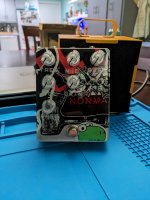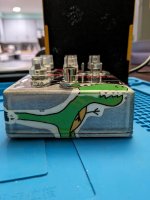Definitely drill first then put strong tape on the backs of the holes from the inside. When you pour the envirotex use a little wooden stirrer to fill the holes first and that way you won't get any flow marks from it running through the holes.
Once it's set leave it a few days to fully cure and then use a stepped drill bit to drill out the envirotex. If you use a regular drill bit or try and drill an enclosure after pouring the bit will lift the envirotex off the enclosure.
Juan Solo and Cleggy over on Madbean did the definitive guide for envirotex. I'll post it later for you after I get home.
Edit - Looks like I already posted this in a different thread. If you follow this you should get a pretty good finish. The only things I'd add is make sure you don't have high humidity or you might end up getting some blushing (weird rainbow effect like petrol poured on water). In winter I leave a dehumidifier going in the room when they cure.





